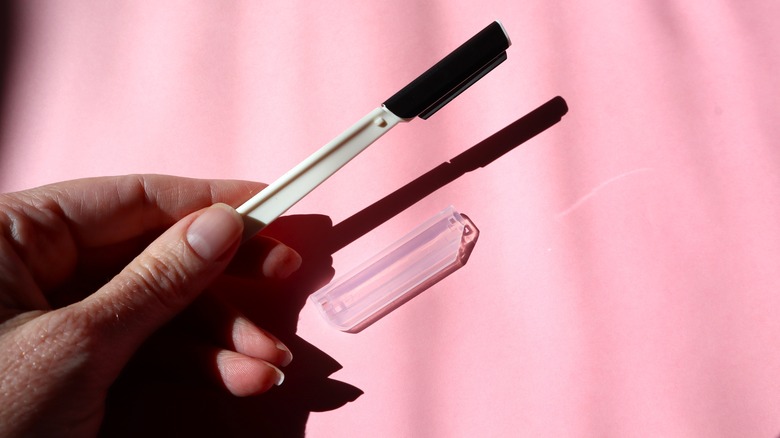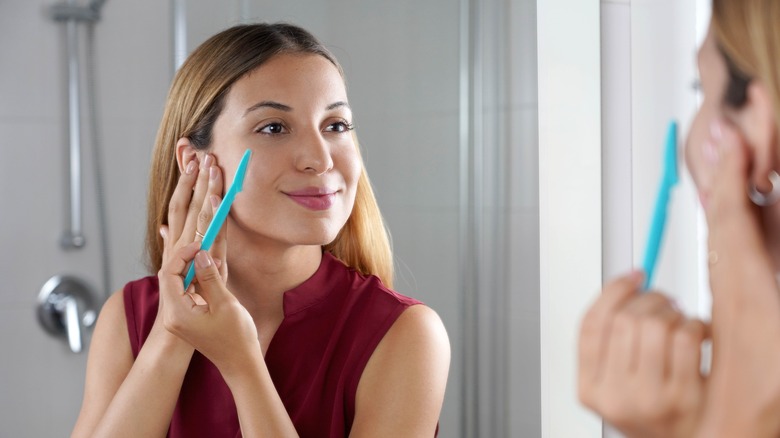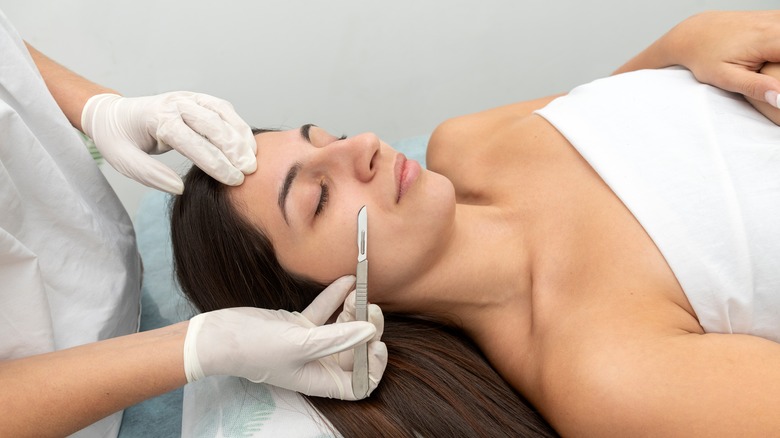The Pros And Cons Of Face Shaving For Women
Shaving your face is natural no matter what gender you are. While there has long been a stigma surrounding face shaving among women, social media, particularly TikTok, is opening a discussion on this form of self-care. In one video, TikTok user @thatgirlsare noted, "It's not only men that have thick, dark facial hair. And it's not only men that shave their face with razors." She added, "Let's normalize some girls having thick dark facial hair and using razors to shave." Face shaving, also known as dermaplaning, can remove vellus hairs (peach fuzz) and terminal hair or dark facial hair.
Although some women, like @thatgirlsare, use a body razor, experts recommend you use an eyebrow razor for face shaving. Dermatologist Mona Gohara explained why to USA Today. She said, "It's different from a regular razor, because you can get a better angle with the long dermaplaning tools and it's also less sharp than razors, which are meant to cut thick hairs." So what's the right way to approach face shaving?
Before putting the eyebrow razor on your skin, ensure your face is clean and without makeup. Second, wet your face and use shaving cream or gel such as aloe vera. As you shave, hold your skin tight and shave the hair in the direction it grows. Lastly, moisturize. Razor subscription service Jill demonstrates this process in a brief tutorial on TikTok. Despite having many benefits, face shaving has certain drawbacks. Here are the positive and negative sides.
Dermaplaning leads to glowing skin
Face shaving and dermaplaning are the same idea, but there is one main difference between the two. Dermaplaning, using an eyebrow razor, provides the skin with a glow. Dermatologist Azadeh Shirazi told USA Today, "It's more than just a method for hair removal. It's a much deeper exfoliation treatment... so removing the dead skin cells allows for better penetration of your skincare products, making them more effective. It also allows for makeup to go on smoother." In addition, dermaplaning gets rid of debris and oil. It softens the skin and could ultimately give you more self-confidence about your bare complexion.
Likewise, dermaplaning can reduce dark spots and the appearance of fine lines or wrinkles. It can also help with acne scarring. Although some believe dermaplaning causes facial hair to grow back thicker, this is not the case. Mona Gohara explained to USA Today, "There are different factors that play into this like age, hormonal influences and genetics. That's what influences the amount of hair and how thick it is — not how you remove it."
While you could get professional dermaplaning done at a dermatologist's office, dermaplaning at home is entirely safe. Best of all, it's inexpensive and effective. Depending on your hair growth, you can expect to do it about every six weeks.
Dermaplaning isn't for everyone
For all its excellent benefits, face shaving and dermaplaning are not ideal for every skin type. Dermaplaning is not recommended for individuals with dry skin and sensitive skin. Experts warn that those suffering from rosacea, eczema, acne, or skin cancer should also avoid dermaplaning. It could worsen your skin and lead to infections, scarring, and breakouts. Opt out of dermplaning if you're susceptible to ingrown hairs or irritation bumps while shaving. Like any hair removal with a razor, dermaplaning can cause cuts or razor burns. For people with have thick terminal hair, dermaplaning could cause the appearance of a five o'clock shadow, perhaps leading to more frequent shaving.
In an article for Refinery29, Jacqueline Kilikita wrote about her negative experience with professional dermaplaning. Kilikiti, who suffers from hirsutism, which causes excessive facial hair, noted that after dermaplaning, her skin "felt sore and looked unnervingly red." While she said she liked the smooth look that dermaplaning gave her face, Kilikiti admitted that it led to more ingrown hairs than usual.
If you have any concerns about side effects, consult a dermatologist before dermaplaning or consider other hair-removing alternatives such as waxing or laser hair removal. If you plan to try dermaplaning, experts recommend always using a different razor than the one you use on your body and thoroughly cleaning your skin. If your skin is irritated or inflamed for any reason, wait for it to clear up before dermaplaning.


